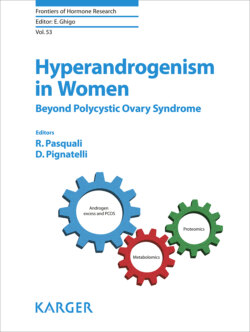Читать книгу Hyperandrogenism in Women - Группа авторов - Страница 27
Introduction
ОглавлениеAndrogens encompass several steroid hormones that may be de novo secreted by gonads and adrenal glands or produced in different tissues from circulating precursors. According to their natural ability to bind the androgen receptor (AR), they can be classified into 2 subgroups: the true androgens (active ones), represented by testosterone (T) and its 5α-reduced metabolite dihydrotestosterone (DHT), and pro-androgens (weak ones), including dehydroepiandrosterone, dehydroepiandrosterone-sulphate and androstenedione (A), which begin to be active as far as converted into T and DHT. Recently, it has been pointed out that the major weak androgen is 11β-hydroxyandrostenedione, which is synthetized by the adrenal glands and can be converted both into 11β-hydroxytestosterone and, thereafter, into 11β-hydroxydihydrotestosterone by the 5α-reductase in target tissues; these last 2 androgens bind the AR as well, although being less active than T and DHT [1].
The synthesis of androgens in the gonads is regulated by the luteinizing hormone (LH), secreted by the pituitary gland upon the hypothalamic action of the gonadotropin-releasing hormone (GnRH). Indeed, LH acts on Leydig cells in males and theca cells in females via the steroidogenic acute regulatory protein, promoting the transfer of cholesterol to the inner mitochondrial membrane. Despite common pathways, androgens show sex-dependent features. In males, testes synthesize T, which is converted into DHT in target tissues, such as prostate and seminal vesicles. In females, ovaries synthesize about the half of the circulating T and smaller quantities of dehydroepiandrosterone and A; the remaining T is produced from the conversion of circulating weak androgens (mainly from A). The secretion of adrenal androgens is commonly regarded as being LH-independent and is predominantly characterized by the synthesis of weak androgens in both sexes.
Given that AR is present, hormones can exert their effect in the vicinity of the secreting gland or enter the blood stream. In both sexes, A and T can be converted into oestrogens by aromatase in different tissues, including visceral adipose tissue (VAT). The principal end-metabolites of androgens is androsterone glucuronide (ADTG) and 5α-androstane-3α,17β-diol glucuronide (ADG), produced mainly in splanchnic tissues (gut and liver) rather than in peripheral ones (skin and male internal genitalia). Extra-gonadal metabolic pathways are not influenced by LH but are modulated either by the characteristics of local enzymatic pathways and their co-regulators (i.e., IGF-1) or by the type and quantity of androgens locally present [2, 3].
In males, androgens are responsible for the development of primary and secondary sexual characteristics, whereas in both sexes, they influence sexual behaviour, glycaemic control, lipid profile, bone metabolism and erythropoiesis [4–6]. The present paper aims at reviewing androgen metabolism and its influence on body composition in both sexes.
